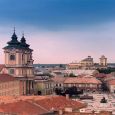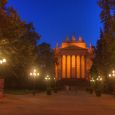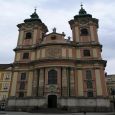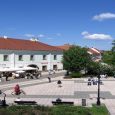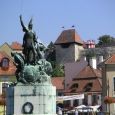Eger
Advertisement
By Train
The main railway station is located 1,5 km from the city center.MAV operates fast train services to Budapest, and the trip is about 1 1/2 hours.This is called the intercity train.The regional train takes just over 2 hours with no changing of trains.Local trains to Fuzesabony and Szilvasvarad also depart from this station.Almar is a popular stop for weekend gardeners and hikers alike.There are also smaller stations located near the Castle (Varallomas), and in the Felnémet district, that are served by the Eger - Szilvasvarad local trains.
By Bus
Agria Volan also operates a fleet of local buses, serving most parts of the city, although the majority of buses run in North - South direction.Line 12 is the busiest line in the city, and it has stops at the Main Railway Station, the long distance bus station and in the city centre.The long distance bus stop is in the city center.Buses depart approx. every 30 minutes to Budapest, and the trip to the capital is about 1 1/2 hours.Agria Volán operates an extensive network of suburban and long distance buses. Other bus companies also offer connections to a variety of destinations.Taking the bus to Felsotarkany gets you close to several hiking and mountain biking trails that start in town.Trails are well marked, and maps come in handy when identifying trailheads starting from town.
By Car
The easiest way to arrive is to take the M3 as far as Fuzesabony, then continue north on route 25.For a more scenic route from Miskolc you can drive through the windy roads of the Bükk mountains.
Advertisement
Castle of Eger
Is a castle in Eger, Hungary.Historically, it is known for its repelling of the Turkish attack in 1552 during the Siege of Eger.The first castle was built on the high hill named Varhegy at Felsotarkany near Eger.During the Mongol invasion in 1241, this castle was ruined, and the bishop of Eger moved it to a rocky hill in the city of Eger. On the hill, a new castle was built, and it developed rapidly. In 1470 a Gothic palace was built. In 1552, a Turkish army of 80,000 soldiers attacked the castle which had 1,935 defenders.The siege failed as the defenders killed more than 8,000 Turks.A total of 1,700 of the defenders survived.In 1701, the Austrians exploded half of the castle (the Kulso var).Archaeological excavations only started in 1925 and the castle was used by the army as barracks until 1957.
The Baroque Minorite Church
Built to the designs of Kilian Ignaz Dientzenhofer of Prague with original ceiling frescoes by Marton Reindl, is the focal point of the city's most imposing square, flanked by the City Hall and the old priory buildings, part of which contain the Paloc Museum, showing the artefacts of a distinctive regional ethnic community.The square and several of the retail streets around it are pedestrianized.
Archbishop's Garden
Is a park in Eger, Hungary, that covers about 12 hectares.It was created on the area of a former hunting ground.The park walls were built by Bishop Esterhazy.Some of these walls are still standing on the northern and western side of the park.The park was opened to the public in 1919.
Serbian Orthodox Church
Is in Zopf style (1784–86).The interior was commissioned from the best Viennese artists by the rich local Serbian community of that time. It is dominated by a breath-taking iconostasis.
The Lyceum
Designed by Jozsef Gerl and Jakab Fellner and built in 1765-85, is a splendid example of the restrained Zopf style.There are three remarkable 18th-century frescoed ceilings, of which only the one in the library is open to the public.Painted by the Viennese artist Johann Lukas Kracker in 1778, it depicts the Council of Trent of 1545-63, which launched the Counter-Reformation. Among the figures depicted are the Reformers Luther and Zwingli, whose "heretical" books are being struck by a bolt of lightning.The beautifully furnished library opened in 1793.There is a camera obscura or periscope at the top of the building, projecting images of the city onto a table.
August - December
March - June
Information not available
Advertisement

